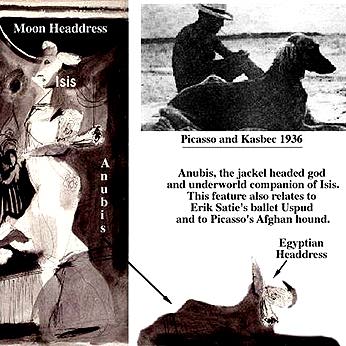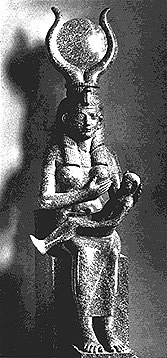|
|
Isis |
|
 If you've found this site useful, we'd really appreciate a small donation to help with the hosting costs. Thanks! |
The female figure on the right of the drawing appears to represent Isis wearing her traditional moon headdress and in the company of the god Anubis her jackel headed companion.
Isis represents different aspects of the feminine archetype, in ancient Egypt, she was the mother goddess and the queen of the underworld. In Egyptian art she was often depicted in the presence of her underworld companion Anubis, who conveyed the souls of the dead for judgment.
The cult of Isis continued to be practised throughout the former Roman Empire right up to the sixth century AD when it was finally driven underground by Christianity. Isis lived on within certain esoteric traditions throughout the middle ages and continues to be an important part of the Alchemical tradition, which is almost certainly why she is represented in the 1934 drawing.
© Mark Harris 1996 Alchemical ContextsNext Section: Interpretations of the 1934 Drawing |
|
|
|
     |
     |
|
|
© Mark Harris 1996 (content), Simon Banton 1996 (design) In general copyright of works by Pablo Picasso are the property of the heirs to the Pablo Picasso estate |
|


 In the Roman Empire, the cult of Isis was very popular throughout the Mediterranean area. It focused on the celebration of the mysteries of the death and the resurrection of Osiris. Isis, had been the consort of Osiris, and after his murder she recovered the scattered parts of his body and restored them to life. Osiris then became king of the dead and his son Horus became king of the living. The story of Isis, Osiris and Horus parallels the Christian mysteries of the virgin birth and the resurrection. It is also the origin of certain the Christian symbol of the Madonna and Child.
In the Roman Empire, the cult of Isis was very popular throughout the Mediterranean area. It focused on the celebration of the mysteries of the death and the resurrection of Osiris. Isis, had been the consort of Osiris, and after his murder she recovered the scattered parts of his body and restored them to life. Osiris then became king of the dead and his son Horus became king of the living. The story of Isis, Osiris and Horus parallels the Christian mysteries of the virgin birth and the resurrection. It is also the origin of certain the Christian symbol of the Madonna and Child.